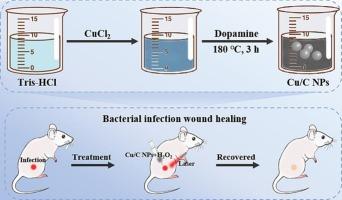富酚Cu/C纳米颗粒通过ROS生成和光热消融细菌感染促进伤口愈合
IF 6
2区 医学
Q2 MATERIALS SCIENCE, BIOMATERIALS
Materials Science & Engineering C-Materials for Biological Applications
Pub Date : 2025-09-22
DOI:10.1016/j.bioadv.2025.214514
引用次数: 0
摘要
耐抗生素细菌的出现对人类健康构成重大威胁,迫切需要制定替代治疗策略。本研究以多巴胺为碳源和还原剂,采用一锅法制备了铜掺杂碳基纳米粒子(Cu/C NPs)。Cu/C NPs表面富集螯合酚基团,减少Cu+/Cu2+浸出,提高生物安全性。由于它们具有优异的过氧化物酶样(pod样)活性和光热特性,这些纳米颗粒被广泛用于抗致病性细菌感染的化学动力学和光热疗法,在体外对金黄色葡萄球菌(100%)和大肠杆菌(97.7%)显示出广谱杀菌活性。此外,体内抗微生物试验也表明,Cu/C NPs促进感染伤口愈合,从而为临床治疗致病菌感染提供了新的途径。本文章由计算机程序翻译,如有差异,请以英文原文为准。

Phenolic-enriched Cu/C nanoparticles for enhanced wound healing via ROS generation and photothermal ablation of bacterial infections
The emergence of antibiotic-resistant bacteria poses a significant threat to human health, urgently requiring the development of alternative therapeutic strategies. In this study, copper-doped carbon-based nanoparticles (Cu/C NPs) were synthesized by one-pot method using dopamine as the carbon source and reducing agent. The surface of Cu/C NPs were enriched with chelating phenolic groups to reduce Cu+/Cu2+ leaching and improve biosafety. As they exhibit excellent peroxidase-like (POD-like) activity and photothermal properties, these nanoparticles were broadly used in chemodynamic and photothermal therapies against pathogenic bacterial infections, demonstrating a broad-spectrum bactericidal activity in vitro against S. aureus (100 %) and E. coli (97.7 %). In addition, in vivo anti-microbial tests also showed that Cu/C NPs promote infected-wound healing, thus providing a new approach to combating pathogenic bacterial infections in the clinic.
求助全文
通过发布文献求助,成功后即可免费获取论文全文。
去求助
来源期刊
CiteScore
17.80
自引率
0.00%
发文量
501
审稿时长
27 days
期刊介绍:
Biomaterials Advances, previously known as Materials Science and Engineering: C-Materials for Biological Applications (P-ISSN: 0928-4931, E-ISSN: 1873-0191). Includes topics at the interface of the biomedical sciences and materials engineering. These topics include:
• Bioinspired and biomimetic materials for medical applications
• Materials of biological origin for medical applications
• Materials for "active" medical applications
• Self-assembling and self-healing materials for medical applications
• "Smart" (i.e., stimulus-response) materials for medical applications
• Ceramic, metallic, polymeric, and composite materials for medical applications
• Materials for in vivo sensing
• Materials for in vivo imaging
• Materials for delivery of pharmacologic agents and vaccines
• Novel approaches for characterizing and modeling materials for medical applications
Manuscripts on biological topics without a materials science component, or manuscripts on materials science without biological applications, will not be considered for publication in Materials Science and Engineering C. New submissions are first assessed for language, scope and originality (plagiarism check) and can be desk rejected before review if they need English language improvements, are out of scope or present excessive duplication with published sources.
Biomaterials Advances sits within Elsevier''s biomaterials science portfolio alongside Biomaterials, Materials Today Bio and Biomaterials and Biosystems. As part of the broader Materials Today family, Biomaterials Advances offers authors rigorous peer review, rapid decisions, and high visibility. We look forward to receiving your submissions!

 求助内容:
求助内容: 应助结果提醒方式:
应助结果提醒方式:


